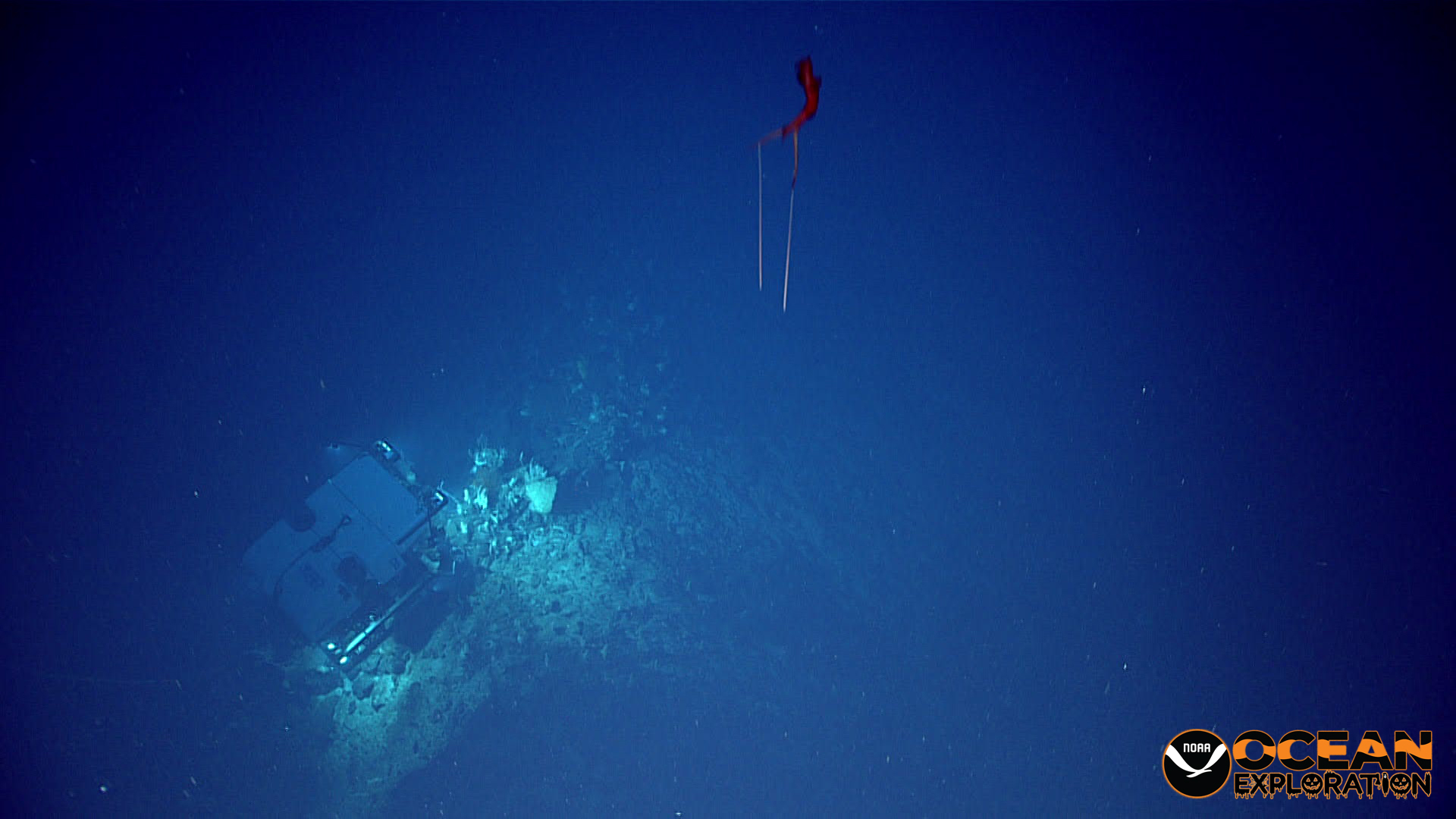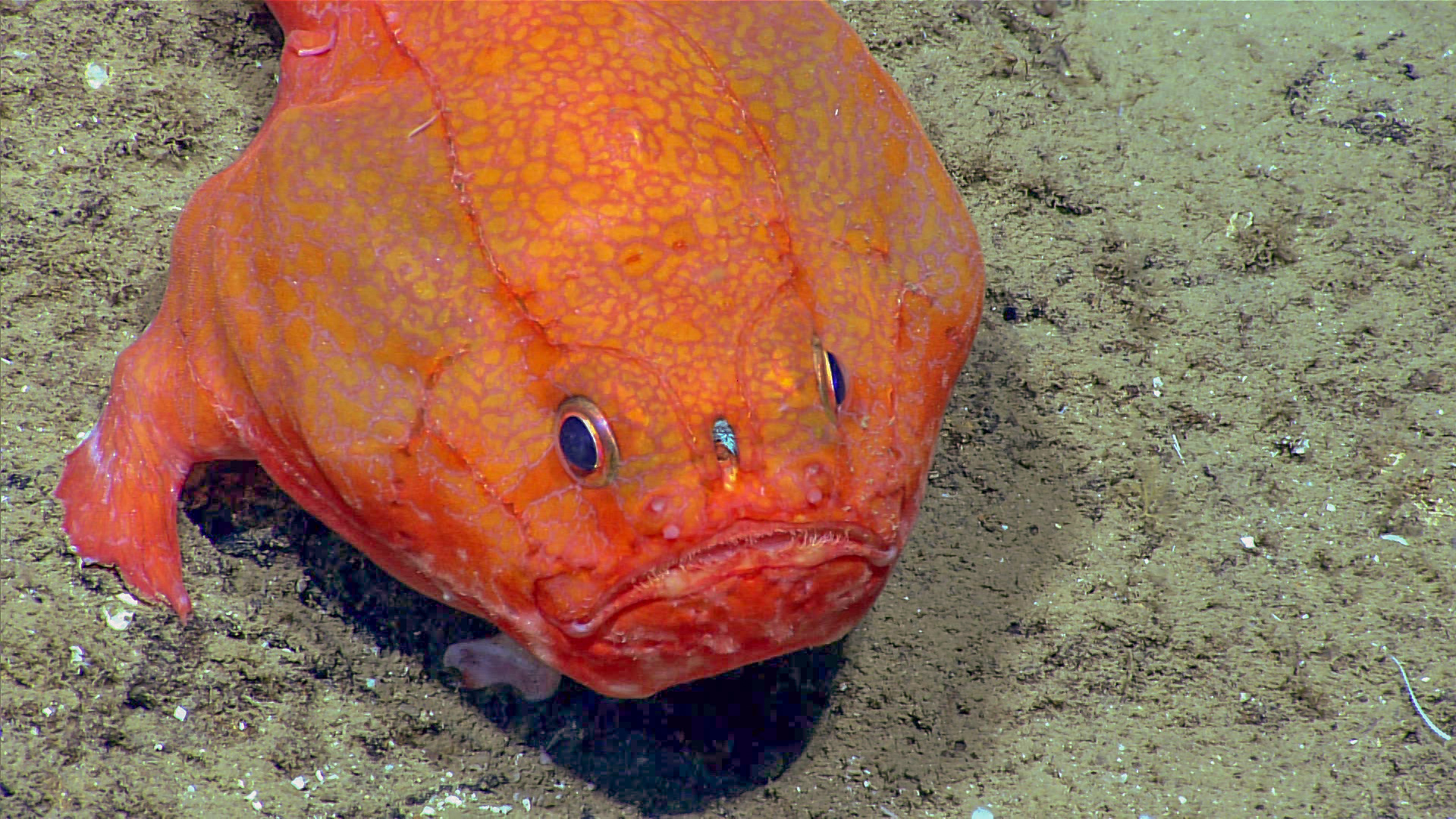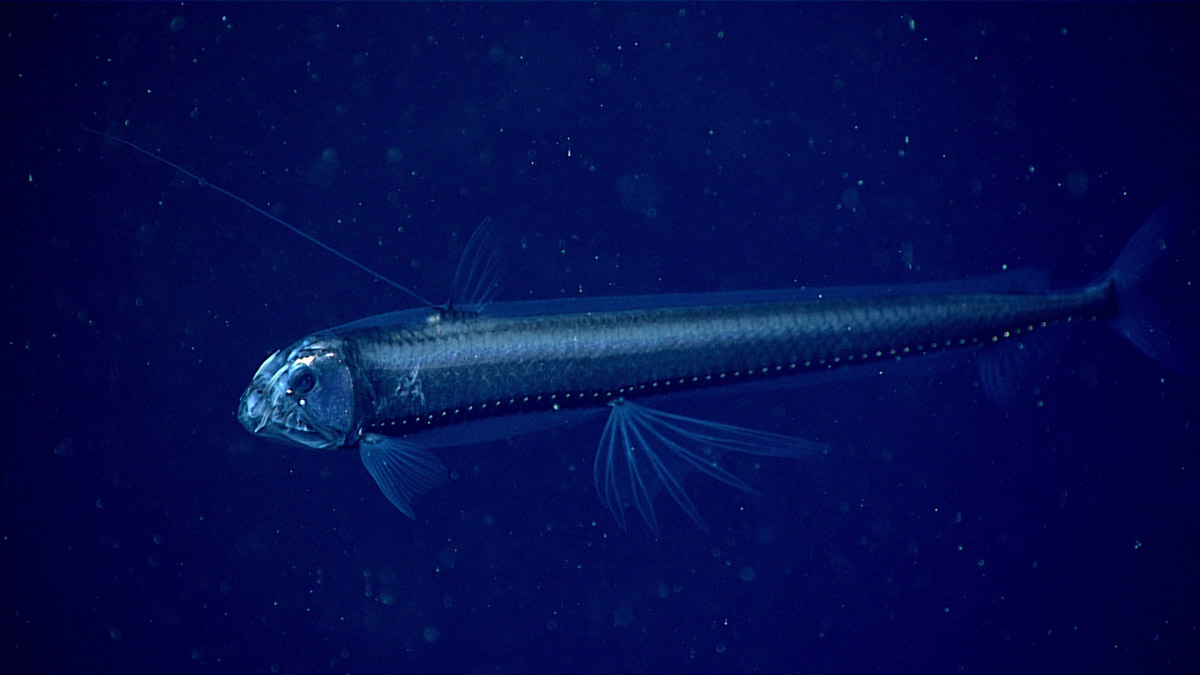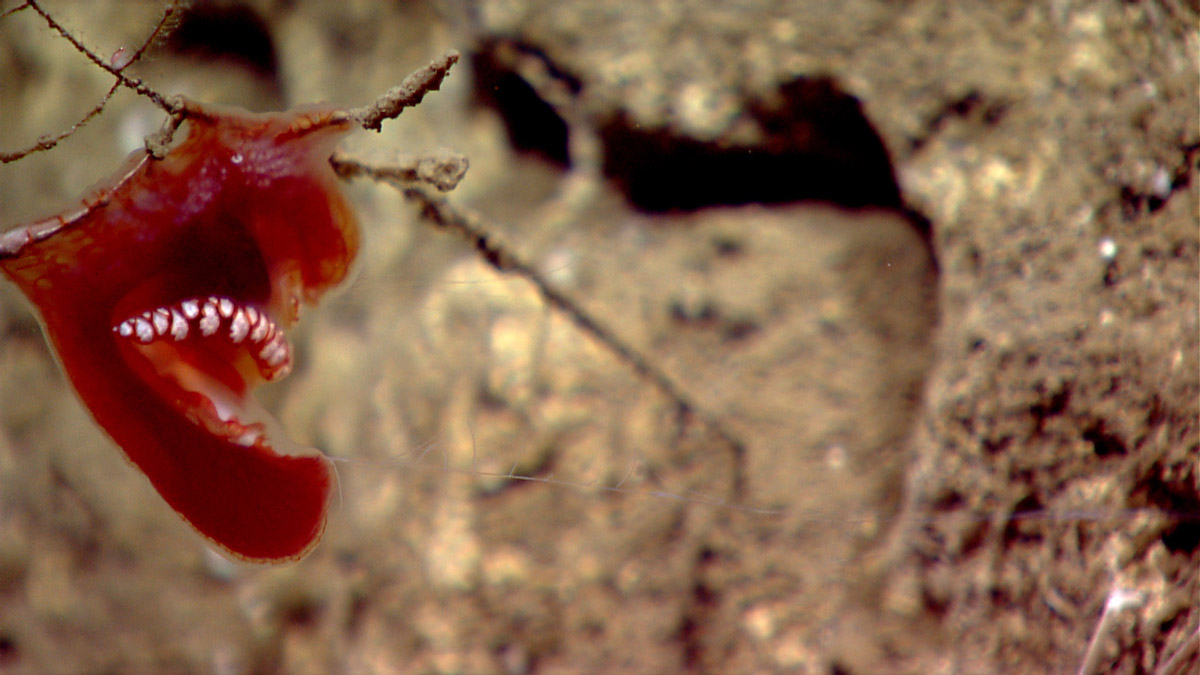31 Dives of Halloween
It’s October. The days are getting shorter and cooler, leaves are changing colors and starting to fall, a new fiscal year has begun for the federal government, and Halloween is just around the corner. To celebrate this haunting holiday, we’ve gathered some of our favorite spooktacular finds from the deep ocean. We’ll reveal a new one each day, so be sure to check back often or follow us on social media to see what we uncover next!
Of course, if we’re creepin’ it real, while the depths of the ocean may be dark, cold, and mysterious to us, this enormous habitat is more fascinating than it is scary. And the deep ocean and the boo-tiful animals that live there are critical parts of our planet’s ecosystem. The more we explore, the better we can unlock the secrets of this eerie-sistible underwater realm, allowing us to more effectively manage and protect its resources... and there’s nothing frightening about that!
Happy Halloween, explorers!

It’s October! Time for all things spooky.
October 1, 2022

In addition to enjoying a new haunting ocean find each day on this page, “treat” yourself by dressing up your desktop with our newest desktop wallpaper, featuring this eerie squid seen during the third Voyage to the Ridge 2022 expedition. Download it here so that you can gaze at its spookalicious glory each time you log into your computer!
Creepy, crawly, and full of slime – no worming out of this one!
October 2, 2022
Seen during Dive 09 of the 2021 North Atlantic Stepping Stones expedition, this nemertean worm (which belongs to the phylum Nemertea) is also known as a ribbon worm or proboscis worm. The latter name comes from the worm’s impressively long proboscis that is used for hunting. As a stress response, these worms can actually split into pieces! They also have the ability to produce a slippery, slimy mucus to help them creep across the seafloor.
View original video.Pumpkin Carving Templates: Creatures of the Deep Ocean
October 3, 2022

This Halloween, trick or treat yourself with some fun ocean-themed pumpkin carving templates! From a spooktacular sea star to a ghost shark, you’re sure to find something to carve that will have you thinking, “life is gourd.”
Meet the spooky spider that spins no web: the sea spider!
October 4, 2022
Creep it real this Halloween by learning the truth about sea spiders: they aren’t really spiders! Despite their common name of “sea spider,” pycnogonids aren’t really spiders like the ones that might give you a fright on Halloween. Sea spiders and spiders both belong to the phylum Arthropoda, but they belong to different classes. So, although they are related, sea spiders and spiders are not the same creature.
We saw this long-legged sea spider ambling along a seafloor covered with pillow lavas at a depth of 1,477 meters (4,846 feet) during Dive 09 of the second Voyage to the Ridge 2022 expedition. The presence of the two thin orange limb-like structures hanging below the sea spider indicate it is likely a male; called ovigerous legs, these structures are used for holding and carrying eggs.
View original video.What big teeth you have, Mr. Deep-Sea Lizardfish!
October 5, 2022
Deep-sea lizardfish (Bathysaurus cf. mollis) typically lurk on the seafloor, hiding in wait for unsuspecting prey...but this one surprised us as it swam up and through the water column as we explored an extinct hydrothermal vent chimney in the Mariana region.
With their mouths full of needle-like sharp teeth, deep-sea lizardfish may be nightmarish in their appearance, but these fish are some of the deepest-known top predators in the ocean and serve an important role in the overall balance of the ocean food web. As food is scarce in the deep ocean, lizardfish feed on what they can find – including other deep-sea lizardfish!
View original video.This dandelion siphonophore radiates a pumpkin-ish glow.
October 6, 2022
Even though they are rare, we were lucky enough to see dandelion siphonophores on three dives during the Deepwater Backyard: Exploring Atlantic Canyons and Seamounts 2014 expedition, including this one imaged during the Atlantis II Seamounts dive that resembled a glowing, festive pumpkin!
Perhaps we ought to name it “Jack”?
In scientific terms, dandelion animals are physonect siphonophores. They are a type of colonial hydrozoan and a type of cnidarian, meaning they are closely related to corals, sea anemones, and jellyfish. Like other siphonophores, dandelion siphonophores are actually composed of many individuals that all work together with some protecting the colony, some catching food, some reproducing, etc.
Casper the Friendly Octopus
October 7, 2022
No Halloween countdown would be complete without one of our favorite deep-sea octopods, informally dubbed “Casper” due to its ghostly white skin.
We encountered this friendly neighborhood “ghost” during the first dive of the 2016 Hohonu Moana: Exploring Deep Waters off Hawaiʻi expedition, while exploring on the northeast side of Necker Island. The sighting confused several of our shore-based scientists who have never seen anything like it. Upon further review, this ghostlike octopod is almost certainly an undescribed species and may not belong to any yet-described genus.
Boo!
View original video.What’s a witch’s favorite deep-sea critter? Perhaps a WARTY octopus?!
October 8, 2022
This octopus, nicknamed the warty octopus due to the cartilaginous bumps seen along its body, was seen during the Windows to the Deep 2019 expedition.
Happy Halloween…and happy World Octopus Day!
View original video.Zombie Sponge
October 9, 2022
During the third Voyage to the Ridge 2022 expedition, scientists came upon what they dubbed the “zombie sponge” because at first glance, it appears both living and dead. However, things are not always as they appear! What you are actually seeing is the result of sponge larvae settling and growing within the skeleton of its deceased predecessor. That takes some real dead-ication!
View original video.A “Seirios” Stalker
October 10, 2022

Ever get the feeling that you're being watched? If it’s Halloween, that may be super creepy, but if you’re remotely operated vehicle (ROV) Deep Discoverer (D2), you’re probably appreciative of the constant “eyes” on you from ROV Seirios.
Referred to in the industry as a ‘camera sled,’ Seirios is directly tethered to NOAA Ship Okeanos Explorer and then is further tethered to D2 via a cable. Seirios always stays above D2, providing ROV pilots from the Global Foundation for Ocean Exploration an expanded view of D2 and surrounding areas. Shining down on D2 much like its namesake star, Sirius, Seirios acts as a brilliant source of light in the “night sky” of the ocean, literally shedding light on a location’s features and its inhabitants.
And, as Seirios “watches” from above, we are often treated to glimpses of things we'd otherwise miss, such as this whiplash squid observed during the second Voyage to the Ridge 2022 expedition.
Nightmares for days…
October 11, 2022
Halloween heebie jeebies, anyone? We saw this giant blind lobster, seen at a depth of at nearly 4,000 meters (2.5 miles) guarding a series of large burrows with its claws poised for action during the Deepwater Exploration of the Marianas 2016 expedition. It could indeed provide nightmares for days!
View original video.Eye of newt and toe of frogFISH…
October 12, 2022

This anglerfish goes by a whole host of Halloween-ish names, including frogfish and toadfish. Plus, it totally looks like a pumpkin! We saw this one resting on the seafloor during the third Voyage to the Ridge 2022 expedition.
This ghostly bigfin squid is sure to raise your spirits.
October 13, 2022
It’s not every dive that deep-sea explorers encounter a bigfin squid (Magnapinna sp.). It’s actually pretty unusual; roughly a dozen sightings have been confirmed worldwide. So, when we captured an adult bigfin squid on camera during the Windows to the Deep 2021 expedition, while exploring off the West Florida Escarpment in the Gulf of Mexico, it was quite an exciting moment.
View original video.Little Shop of Horrors
October 14, 2022
Feed me, Seymour! Like something out of Little Shop of Horrors, this Venus flytrap anemone traps prey in its “jaws.” The tentacles of anemone have stinging cells that have microscopic harpoons that can then inject venom into captured prey.
Perhaps we ought to name this one…”Audrey II”? It was seen during the 2017 American Samoa Expedition: Suesuega o le Moana o Amerika Samoa expedition, on a seamount dubbed “Moki” in the northern region of the American Samoa Exclusive Economic Zone.
View original video.Small but terrifying monster inspiration.
October 15, 2022
Though small, this bizarre hyperiid amphipod is big on the creepy factor (for Halloween countdowns, at least). The amphipod in this video has attacked a salp and ripped most of its insides out…but has kept enough of the cells inside the salp so that it more or less remains alive. And now the amphipod is basically using the (still-living) salp as its own little “house.”
Also, with large (relatively speaking) claw-like appendages, this kind of amphipod is believed to have provided inspiration for various movie monsters, including Ridley Scott’s nemesis in Alien. Let’s just be grateful that they aren’t bigger in real life…
We saw this amphipod swimming in the water column during the second Voyage to the Ridge 2022 expedition at a depth of 808 meters (2,651 feet).
View original video.It was a dark and stormy…day at sea.
October 16, 2022

While a rough ocean is still a beautiful ocean, it can hamper remotely operated vehicle (ROV) operations. One of the planned dives for the 2019 Southeastern U.S. Deep-sea Exploration on NOAA Ship Okeanos Explorer was canceled due to the rough seas shown here.
It’s never an easy decision to cancel a dive, and there are many factors that guide dive/no dive decisions. Ultimately, no matter how much we anticipate and plan, sometimes dives do get canceled, and it’s always disappointing when we’re unable to share the wonders of the deep with scientists and other dedicated followers who join our exploration live online.
Straight out of science fiction.
October 17, 2022
You don’t need to travel to another planet to find spooky alien-like lifeforms – we’ve got them right here on Earth!
This isopod, unknown to our science team, was seen while exploring a site dubbed (appropriately!) Twin Peaks in the Mariana region at 4,810 meters (3 miles) depth as part of the 2016 Deepwater Exploration of the Marianas expedition.
So many deep (sci-fi) mysteries left to unlock in our ocean.
View original video.Frightening fangs for days!
October 18, 2022

Viperfish are known for their sharp, fang-like teeth that are so big, they don’t fit into their mouths and instead curve upwards towards their eyes. They also have a bioluminescent spine that sticks up in front of their dorsal fin – it’s like a built-in glow stick!
This viperfish, imaged during the 700-meter (2,297-foot) transect to explore the water column above Hydrographer Canyon during the 2021 North Atlantic Stepping Stones expedition.
Trick or treat, smell my feet. Give me…a dead fish head…to eat.
October 19, 2022
This giant isopod (Bathynomous giganteus) scored quite the treat! It was seen snacking on a fish head during the 2019 Southeastern U.S. Deep-sea Exploration.
These deep-sea scavengers are close relatives of the pill bugs, rolly pollies, and sowbugs found in houses and gardens, but Bathynomus giganteus is much, much larger, growing up to a foot and a half in length. How’s that for Halloween horror?!
Although giant isopods have been known to exist for more than a century, we still don't know all that much about their biology or behavior, making capturing videos like this one incredibly important (and also really cool).
View original video.Looking for a last-minute Halloween costume? How about going as a Gorgon, the Greek mythical creature with coiled serpents for hair?
October 20, 2022
The basket star in this video gets its genus name - Gorgonocephalus - from the Greek mythological reference, due to its set of very intricate, serpent-like arms. The arms of basket stars are covered with spines and hooks which allow them to collect small critters.
This basket star was seen while exploring Indonesian waters in 2010. Its intricate network of bifurcating arms also housed several large shrimp.
View original video.You never know who might be your worst anemone.
October 21, 2022
An act of predation was unexpectedly caught on camera when a small fish ventured too close to an anemone during a Voyage to the Ridge 2022 expedition dive to explore Lang Bank, northeast of St. Croix island. Oh, the horror!
View original video.This ctenophore is rather…sinister…in its appearance.
October 22, 2022

This blood-red benthic ctenophore, seen during the Northeast U.S. Canyons Expedition 2013, was quite the treat for biologists, as these animals are a rare find. As we approach the Halloween witching hour, however, this animal almost looks like a gaping, screaming set of viscous jaws (it’s not, though!).
Here’s a treat for you — an Oreo fish!
October 23, 2022
We got a very, very close look at this False Boarfish at 1,660 meters (5,446 feet) depth during the second Voyage to the Ridge 2022 expedition. These fish are part of a group of deep-sea fishes that belong to the family Oreostomatidae, commonly referred to as the “oreos.” These fish tend to maneuver and hover close to steep rock faces and are “nippers and croppers” of small invertebrates. And, despite their “sweet” common name, these fish are known to be aggressive in defending their territory.
View original video.“One person's craziness is another person's reality.” – Tim Burton
October 24, 2022
With its cartoonishly large eyes, this little bobtail squid is right out of a gothic fantasy movie! It was seen at a depth of 1,030 meters (3,380 feet) during a dive to explore Atlantis Canyon as part of the Northeast U.S. Canyons Expedition 2013.
View original video.Dead shrimp walking?
October 25, 2022
While exploring Shostakovich Seamount during the Deep-Sea Symphony: Exploring the Musicians Seamounts expedition, scientists were stumped by this unusual parasite on a Nematacarsinus sp. shrimp. Observed at a depth of approximately 2,730 meters (8,960 feet), the location and appearance of a potential circulatory system led the team to the conclusion that this was a parasite and not an unusual growth or egg mass.
While scientists were not able to specifically identify the parasite, the team was quite sure this would eventually be a fatal relationship.
“It’s real gross.”
View original video.This jelly is out of this world!
October 26, 2022
What would Halloween be without an alien invasion? This spectacular “cosmic” jelly was seen flying through the water column at a depth of approximately 3,000 meters (1.9 miles) during a 2017 American Samoa Expedition: Suesuega o le Moana o Amerika Samoa dive to explore “Utu Seamount,” located in the northern region of the American Samoa Exclusive Economic Zone.
View original video.The Creepy Chimaera
October 27, 2022
When it comes to Halloween, deep-sea fish don’t mess around! Take, for example, this chimaera seen during the INDEX 2010: “Indonesia-USA Deep-Sea Exploration of the Sangihe Talaud Region” expedition.
Although the lines and dots on its face give it a bit of a “stitched together” appearance (perfect for Halloween!), those lines and dots actually serve important purposes. The lateral lines running across this chimaera are mechano-receptors that detect pressure waves (just like ears). The dotted-looking lines on the frontal portion of the face (near the mouth) are "ampullae de lorenzini," and they detect perturbations in electrical fields generated by living organisms.
View original video.Best Halloween costume award goes to...
October 28, 2022
…this “sumo crab” in the family Dorippidae.
Seen during the Océano Profundo 2018: Exploring Deep-sea Habitats off Puerto Rico and the U.S. Virgin Islands expedition, this crab is using specialized hind legs to hold on to a sponge to help camouflage it (or to win a deep-ocean Halloween costume contest). These crabs get their common name of "sumo crab" because some of them have grooves on the carapace that look like the scowling face of a sumo wrestler.
View original video.Upon reflection, perhaps vampire squids aren’t that scary.
October 29, 2022

Image courtesy of the Ocean Exploration Trust.
Despite their common name, vampire squids (Vampyroteuthis infernalis) are neither blood-sucking predators nor squids. Rather, these animals are scavengers, feeding on dead organic material; in fact, they are the only living cephalopod species that doesn’t eat live prey. Like other cephalopods, the vampire squid has developed a variety of adaptations, from bioluminescence, transparency, and dark coloration to survive in the dark world below 1,000 meters (3,280 feet).
Eaten alive…
October 30, 2022
Probably one of the more...graphic...videos on our Halloween horror list, during the final dive of the Discovering the Deep: Exploring Remote Pacific Marine Protected Areas expedition, scientists witnessed a fierce battle between a shrimp and a midwater dragonfish. During this impressive display of predatory behavior, the shrimp was observed impaling and consuming the dragonfish while the fish was still alive! The shrimp also removed several pieces of fish tissue and stomach contents.
View original video.Happy Halloween!
October 31, 2022
Anyone familiar with the movie, “The Nightmare Before Christmas,” might see a resemblance between Jack Skellington’s ghost dog, Zero, and this enchanting rhinochimaera. We encountered this ghostly fish while exploring Hydrographer Canyon as part of the Northeast U.S. Canyons Expedition 2013.
